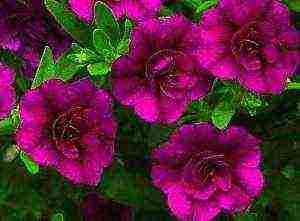Content
Having approached the formation of the pond correctly, having studied the parameters of the water and preparing everything for the launch of the fry, the owner will be able to grow the fish to the optimal size. Careful care and cleaning of the artificial reservoir will increase the amount of fish for sale, and therefore increase the amount of profit.
The content of the article:
- Home fish farming from scratch
- Fish farming as a business at home
- Equipment for the reservoir
- Costs and technology of fish farming
- What is the best fish to breed?
- Growing fish at home on a mini-farm: how to organize it correctly?
At the moment, many experts in the field of fish farming consider the fish business to be quite a promising direction. Therefore, creating conditions for its development can solve the problem of providing the state with fish and help fish farms in such a difficult task as growing various fish species.
Previously, it was popular to breed fish in artificial reservoirs, but in this case, poachers prevented the growth and development of young animals and grown-up individuals, it is for this reason that fish breeders began to engage in organized reproduction and raising fish on mini-farms and at home. But in order for fish breeding to be successful, a novice fish farmer needs to study the breeding instructions and adhere to all the prescribed rules. Without what, domestic fish farming will not bring the desired results?
Home fish farming from scratch
The most important resource for raising any type of fish is water. The growth, development and health of young animals will depend on its quality.
Step one. Creation of an artificial reservoir.
Before proceeding with the creation of a pond, it is necessary to devote time to a complete analysis of the water, having studied all the indicators and quality standards necessary for settling the reservoir with new residents.

For this purpose, it is best to contact Surveillance and ask specialists to carry out the necessary analyzes of the aquatic environment and give advice on improving it, if necessary. If the water quality is not up to standard, do not despair. It is enough to carry out aeration and cleaning of the pond and everything will return to normal.
Step two. Determination of the quality of water resources.
The water in the fish pond must necessarily have the following characteristics:
- Optimal salt ratio;
- Regular and irregular temperature conditions;
- The total number of microorganisms living in it and PH;
- General transparency;
- The presence of minerals necessary for future fish;
- Color qualities;
- The ratio of gases dissolved in water;
If all these characteristics correspond to the declared standards, then it will be possible to grow fish without any problems.
Step three. Launching fry.
Before you start fry into a pond, you need to know what temperature regime is suitable for your chosen fish species. There are fish that are more suitable for cold water, and there are fish breeds that will only feel comfortable in warm water.
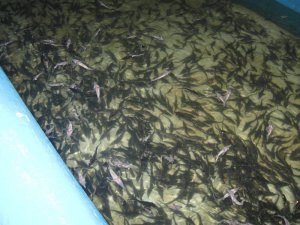
Cold-loving breeds include grass carp, carp, catfish, crucian carp, sterlet, silverheads, trout, peled and salmon. Heat-loving fish need to ensure the water temperature is not lower than twenty degrees, and for those who prefer cool waters from ten to twenty degrees.Wintering in the reservoir will also be determined by the fish species.
Step four. Stages of fish growing.
In order to properly build your mini fish farm, you need to know that breeding stages are taken into account when growing fish. First, the fish spawn, then fry appear, then the wintering stage follows, the next stage of growth, and experienced fish farmers consider the feeding stage as the last step.
Taking them into account, it is possible to clearly distinguish between these periods and create the necessary scheme for the growth and development of young animals and reared individuals. For each of these stages, it is best to equip your own pond or use plastic pools.
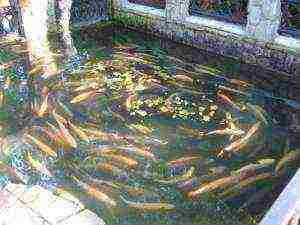
In the pool or pond for spawning, fish farmers are engaged in removing fry from eggs. The hatched fry are transplanted into a pond where they will grow. Upon reaching a certain age, they are placed in a growing reservoir, where they will gain weight. When the generation gets stronger and it will no longer be possible to worry about its health, it is transferred to a feeding pond, but for wintering a special wintering reservoir is used with conditions appropriate for fish.
In order for the fish to grow and develop well, the water in the reservoir must be clean and enriched with oxygen. Also, it should not contain hydrogen sulfide and methane. To avoid their appearance, the pond must be created in an appropriate area, which can be determined using a geodetic map. Also in the reservoir there must be appropriate vegetation, which will saturate the water with substances useful for fish.
Step five. Feeding.
Not only does water play an important role in fish farming, but also the use of appropriate feed additives. In order to grow healthy fish, it is necessary to use feed mixtures appropriate for each breed. They consist of fats, fiber, legumes, grains, proteins, minerals and vitamins that fish need. The secret of success is simple: in order for the fish to grow well, fish farmers fertilize the reservoirs and mineralize them.
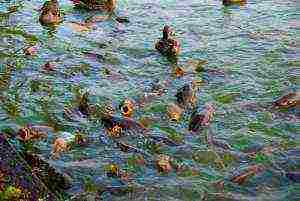
For each age of fish, it is necessary to use its own feed additives, as well as to raise immunity, use therapeutic and stressful feed, which helps the fish to cope with the disease and gain immunity to it. That is, in principle, all that is necessary to know for fish farmers who decide to grow fish at home.
Fish farming as a business at home
The most important thing for growing fish is water, without it it will simply not be possible to breed any of the fish species. It is for this reason that, before deciding to grow fish at home, it is necessary to build a suitable artificial reservoir for it.
For this purpose, you can rent a state reservoir, but this idea is better left. Because it will take you a lot of time to obtain various permits and approvals, and in addition to all this, your "fishing spot" will also be threatened by poachers trying to catch as much fish as possible in your reservoir. For this reason, it is best to forget about renting a pond from government agencies. Moreover, the cost of a business based on state lease will be very expensive for you.
Another option is to create an artificial pond in your country or summer cottage. The creation of an artificial reservoir will also cost a lot, but it will still require much less material and nerve costs from you, and you will also be one hundred percent sure of the reliability of your business.
If you want to breed fish for which fresh water is good, then you can use a polycarbonate greenhouse with a plastic pool installed in it. It also needs to purchase compressor and filtering equipment, which will cost the lack of three thousand dollars. If you can create such equipment yourself, you can significantly reduce the cost of equipment for the reservoir.But before you start creating or purchasing it, you need to find out what kind of equipment and materials you need.
Equipment for the reservoir
Purification of water in a reservoir should be carried out using a gravity filter. It is quite simple to install and it will not take much of your time. It costs about five thousand rubles. It is used not only for water purification, but also allows you to remove microorganisms that cause water bloom and the appearance of mud.
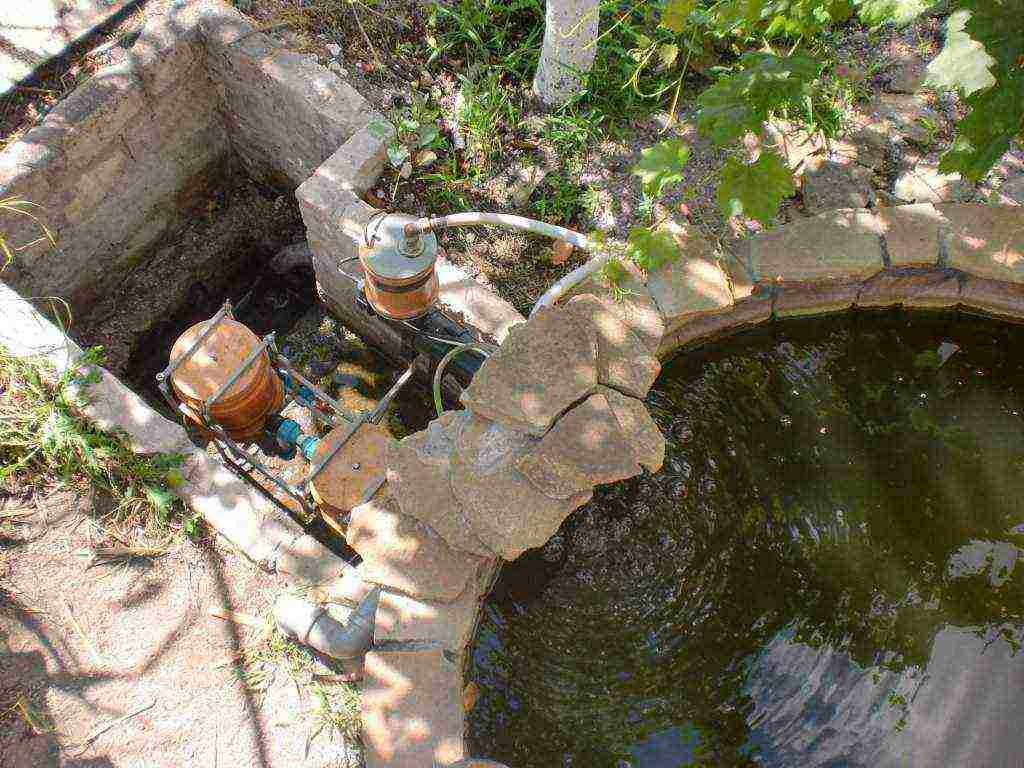
In order to saturate the water with oxygen, compressor equipment is used. Its cost can reach ten thousand rubles. In order to prevent the water in the reservoir from blooming, sterilizers with ultraviolet diodes are used. To pump water out of the reservoir, you need to purchase a hydraulic pump (about five thousand rubles). You can also do it by yourself collecting it from the tubes. In this case, the reservoir will be filled with water from underground sources and springs. Feeders can be purchased at tackle stores. Also, do not forget about the drainage equipment.
Costs and technology of fish farming
The benefits of fish farming are clear. On the market, take, for example, a sturgeon, a kilogram costs about two hundred rubles. Buying fry or breeding them yourself, you can get up to a ton of fish per year, which is about one and a half thousand kilograms, which means three hundred thousand rubles.
Having spent one hundred and fifty thousand on your fishing business, you can work out the costs for a year and still make a profit. The main thing is to find points of sale and then you don't have to worry about profit.
Of course, only those people who understand all the risks and are ready to take them can engage in fish farming, because this type of business is quite competitive. And if you are not ready to fight and breed really high-quality and selective fish, it is better not to start it.
And now, finally, you have made a firm decision to create your own fish farm. What documents do you need? Since you will be starting a business, you will need to register your business. This will also require additional costs. You will also need a license to grow fish, which you will need to issue. And when you get the first "harvest", you still have to go through product quality control and obtain special permission from the relevant structures.
What is the best fish to breed?
While the cost of creating an artificial reservoir is easy to calculate, the cost of purchasing and raising fish is very difficult. It is for this reason that a clear business plan must be drawn up.

The most unpretentious fish in food and maintenance is carp. It is also affordable and affordable. When purchasing a ton of carp fry, you will need to spend about a thousand dollars. Moreover, this fish breed will not begin to multiply immediately, but only after three years. In addition, in the cold season, carps grow twice as slow.
In industrial terms, the most profitable fish species are considered to be all varieties of sturgeon. An adult sturgeon weighs an average of five hundred grams. A kilogram of sturgeon at wholesale will cost about ten dollars. In your artificial pond, you can grow about a ton of such fish in six months. And this means that this business can really be called profitable.
Growing fish at home on a mini-farm: how to organize it correctly?
If you follow all of the above tips, then growing fish in your pond or pool is not a problem. This is exactly what the farmer Mikhail Atamanov, who grows sterlet and trout on his farm in Yaroslavl, does. He grows and sells up to ten tons of fish per year and is not going to stop there. According to him, such a business brings him not only tangible profit, but also pleasure.
In our economically difficult times, many are trying to find alternative sources of income. And if you are one of them, you may be interested in your own fish farm.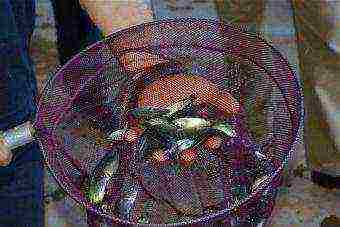 And for this it is not at all necessary to have a pond or a lake in private ownership. A small pond is suitable for this. You can dig a fish pond yourself. Of course, in this case, you will not get big profits, but you will always be able to provide your family with fresh produce. And this, you see, is important. Growing fish at home does not require large expenses, so people can do it even with a small start-up capital. Fisheries technology is akin to animal husbandry: in order to get a good result, it is necessary to create comfortable conditions for aquatic animals. This article will describe some recommendations for growing carp, crucian carp, carp. Fish farming in the country is quite real!
And for this it is not at all necessary to have a pond or a lake in private ownership. A small pond is suitable for this. You can dig a fish pond yourself. Of course, in this case, you will not get big profits, but you will always be able to provide your family with fresh produce. And this, you see, is important. Growing fish at home does not require large expenses, so people can do it even with a small start-up capital. Fisheries technology is akin to animal husbandry: in order to get a good result, it is necessary to create comfortable conditions for aquatic animals. This article will describe some recommendations for growing carp, crucian carp, carp. Fish farming in the country is quite real!
To start with it?
At first glance, fish farming at home is not easy. But this is only at first glance: of course, there are some nuances here, but after overcoming the first difficulties, you will understand that everything is not so difficult. Of course, this venture requires a free area, not necessarily very large. Depending on how many pets you are going to settle in the reservoir, calculate its area and depth. You will also have to purchase fry. If this is not possible, then you can independently catch several individuals during the spawning period. Just remember that in this case the final stage of growing will take a little longer. And yet, the temperature of the water in your reservoir should be exactly the same as in the natural one. Otherwise, the fish will die.
What breeds should I give preference to?
Not sure which fry to start? Before organizing fish farming at home, carefully familiarize yourself with the life features of those species that you would like to see in your pond, and later on the table. If you do not want to bother too much in this matter, then preference should be given to carp, crucian carp, carp, bream, tench.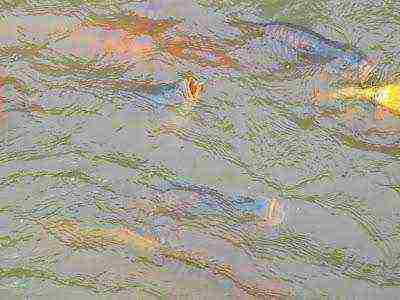
Features of each type
Tench is a very shy fish, so if the choice fell on this particular breed, then take care in advance of a reliable shelter for pets. Lay out a house out of stone and branches where the fish can take refuge. And if the conditions of detention are met, then the fish will gain about two hundred grams in weight per year. Do you think tench grows very slowly? Pay attention to the carp. In practice, it turned out that fish breeding at home becomes more effective if crucians or carps are put into the pond. They grow much faster and are unpretentious in care. These representatives of cyprinids feed on almost everything: algae, insects, porridge, earthworms. This is their favorite food.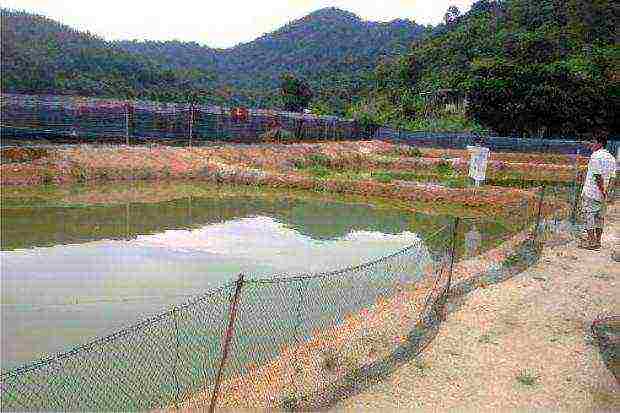
Some nuances
You should pay attention to the following fact. Year-round cultivation in self-dug ponds only makes sense when you have the opportunity to leave the fish for the winter. For this, the reservoir must be deep enough, otherwise the water in severe frosts will freeze to the bottom and aquatic inhabitants will die. If the conditions of keeping do not correspond to the optimal ones, release the fish into the pond for growing in the warm season: April – November.
Feeding features
Of course, in order for the fish to gain weight faster, it must eat well. And for this, the temperature in the pond must be high enough. It is advisable to feed the fish at the same time, then carps and crucians will be waiting for you at the appointed hours. Give steamed grain, small insects, worms as feed. If funds allow, you can buy ready-made fish mixes.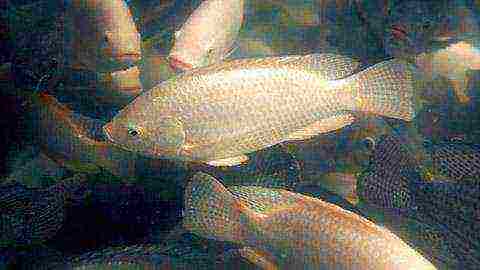 In the presence of a small reservoir, it is better to make a pallet with sides made of galvanized iron, which can be taken out of the water.It is more convenient to sprinkle food on it, and besides, you will be able to observe the intensity with which your pets eat. In the hot season, watch the water level, if it starts to fall, you will have to reduce the number of inhabitants of the pond. You can determine this by how carps behave: if they float to the surface and gasp for air, then there is not enough oxygen in the water. For a favorable existence, crucians and carps need a water temperature of twenty-twenty-seven degrees. You will have finished products for the third season. Now you know that fish farming at home is a painstaking, sometimes difficult task, but very interesting, and most importantly - profitable. Of course, a good result will be influenced not only by your efforts, but also by the weather conditions. Any seasoned fish farmer will tell you that you can adapt to anything. And then there will always be fresh fish on your table. And you can always easily sell the surplus on the market. Those who are interested in growing fish at home can only wish good luck!
In the presence of a small reservoir, it is better to make a pallet with sides made of galvanized iron, which can be taken out of the water.It is more convenient to sprinkle food on it, and besides, you will be able to observe the intensity with which your pets eat. In the hot season, watch the water level, if it starts to fall, you will have to reduce the number of inhabitants of the pond. You can determine this by how carps behave: if they float to the surface and gasp for air, then there is not enough oxygen in the water. For a favorable existence, crucians and carps need a water temperature of twenty-twenty-seven degrees. You will have finished products for the third season. Now you know that fish farming at home is a painstaking, sometimes difficult task, but very interesting, and most importantly - profitable. Of course, a good result will be influenced not only by your efforts, but also by the weather conditions. Any seasoned fish farmer will tell you that you can adapt to anything. And then there will always be fresh fish on your table. And you can always easily sell the surplus on the market. Those who are interested in growing fish at home can only wish good luck!
Many people ask the question: is it possible to breed fish at home? There is nothing difficult in fish farming in everyday life. It is enough to simply follow the generally accepted rules of feeding, and compliance with the necessary conditions. First of all, you need to decide what kind of fish you will grow. At home, it is practically possible to breed up to 40 species of freshwater fish, but each species must be bred according to a specific method. Some fish are less whimsical to the conditions, others are more delicate.
If you have never been engaged in fish farming before, it is easier to choose the most popular species, such as crucian carp, carp, carp. Crucian carp is a less valuable fish, because it gives a small increase in weight. The best option is carp and carp breeding.
What is needed for this?
- First and foremost, it is a body of water;
- Fish fry;
- Feed;
Depending on the volume of the reservoir (boat, feeding places, etc.).
WaterDepending on the reservoir, its size, depth, flow of water, you can draw conclusions about how many fish to launch and which one. Carp or carp are not whimsical enough to the reservoir. Therefore, it can be a reservoir with standing or running water. The average depth is about 1.5 meters, but if you want to leave the fish for the winter, you should take into account that it needs a significant amount of oxygen for the winter, so the reservoir should be of considerable size. You should not leave the fish for the winter in shallow bodies of water - it will simply die in the winter.
To breed carp or carp, it will be enough to start with a reservoir of 50 square meters, but the amount of fish in such a reservoir will also be small.
Fish fry
When stocking a pond, one should take into account the factor for which fish will be needed (for industrial breeding, or for amateur fishing), the stocking density depends on this. So, if the goal is not to feed and sell fish in the fall, the optimal ratio is considered to be 1 kilogram of fish per cubic meter of water. If you are interested in an industrial option, and the necessary auxiliary equipment is available (compressors for air supply, cooling or water heating systems), then you can plant up to 5 kilograms of fish per cubic meter.
You should purchase a wintering carp or carp fry. The weight of such fish is about 25-70 grams, this is the best option. Do not take 200 gram copies if they are two years old. This is a very low weight, that is, the fish has lost weight in previous years and nothing worthwhile will grow out of it.
It should be noted: carp or carp is the optimal type of fish for breeding at home, also because it is gaining weight very quickly.
Feed
Food plays an important role in the life cycle of fish. It depends on him how bistro carp or carp gains weight. There are two feeding options here:
The first option is not industrial. The optimal solution if you breed fish for your own needs.Many cereals are suitable as feed: wheat, corn and others. A good result in weight gain is provided by compound feed and specialized fish feed. However, you can also feed waste from bakeries (crackers, stale bread).
If you are pursuing the goal of industrial fish feeding, then it is necessary to introduce more nutritious feed into the diet. Now widely used for industrial purposes feed from the larvae of the kitchen fly. To do this, special devices are installed above the feeders, where the fly lays eggs, which turn into larvae and suck in water. It is maggot that gives carp and carp a lot of nutrients, and the fish is capable of growing up to 1 kilogram from fry in a season.
Fish farming is a very exciting process that can bring not only sports interest, but also benefit.
Source
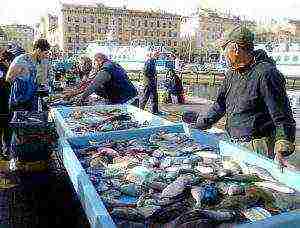 The food business has been considered extremely profitable at all times. Home-made organic products are always appreciated. One of the options for such a business is fish farming.
The food business has been considered extremely profitable at all times. Home-made organic products are always appreciated. One of the options for such a business is fish farming.
Fish is a universal product suitable for almost everyone, so the demand for it is very high. On the shelves of shops, in addition to the products of farm reservoirs, you can often find fish grown at home. This type of business is suitable for both residents of small settlements and entrepreneurs from large cities.
Fish farming requires preliminary preparation and obtaining the necessary knowledge. It is not enough just to find a place to grow fish, buy fry for breeding and wait for them to gain mass.
For the business to be really profitable, it is advisable to study the experience of colleagues at the very beginning, visit fish farms, get acquainted with the conditions for breeding fish of different species.
Valuable advice and experience from colleagues can go a long way towards getting started.
In addition to knowledge, at the initial stage, financial investments will be required to equip the reservoir, purchase the necessary equipment, cover operating and other costs.
What kind of fish is better to breed
A feature of fish farming is the relatively quick payback of the business, since the fish grows rapidly and gains weight, which means that the return on investment is not long in coming. Many species of fish are fast-growing, and they are the most popular.
Most often, the following types of fish are grown at home:

- carps;
- fish of the salmon family;
- sturgeon fish;
- catfish;
- tilapia, trout.
Carp breeding is widespread throughout the post-Soviet space. Carps are omnivorous, but they tend to consume aquatic insects, worms, molluscs and zooplankton. With the right diet, they grow quite quickly.
Catfish are famous for the fact that they easily get along in water bodies with other types of fish. Tilapia is large and fast growing.
Salmon and sturgeon fish feed mainly on other fish. Breeding them can be risky given the high cost of feed and the low consumer demand associated with the high cost of these fish species.
What is required to organize a business
To organize a business related to fish farming, you will need:
- an organized space for growing fish (artificial reservoir, pool or natural body of water);
- cleaning equipment, pumps and other devices (for example, used for automated feeding of fish);
- feed and feed additives;
- directly fry.
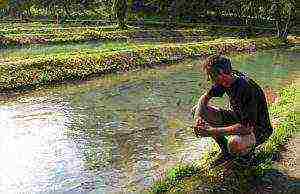 Initially, there may be costs associated with the purchase or lease of land, premises, the arrangement of water bodies, the purchase or rental of vehicles, water supply devices and oxygen sensors.
Initially, there may be costs associated with the purchase or lease of land, premises, the arrangement of water bodies, the purchase or rental of vehicles, water supply devices and oxygen sensors.
In addition, funds will be needed to pay for electricity, fuels and lubricants and chemical components.Expenditures can also include taxes, salary payments to employees involved, mobile services, and more.
All of these costs must be factored into the business plan. In addition to costs, the document should contain the approximate time frame for reaching the recoupment of costs and making a profit. Even before organizing all the work, it is necessary to clearly understand what will be the marketing channels for the farmed fish or fish products.
Features of growing fish
Fish farming is a specific industry that requires knowledge in topics such as water quality control, disease control, organization of proper nutrition and others.
For fish farming, a constant source of quality water is a prerequisite.
The water temperature can be adjusted depending on what kind of fish is being bred in the reservoir.
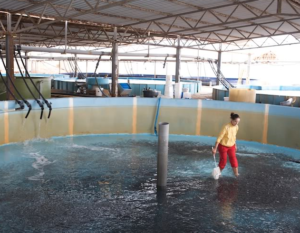 It is important to equip convenient shores of the reservoir so that there are no difficulties with feeding and catching fish. Artificial fish tanks should be of a comfortable size. Most often, for fish breeding, rounded plastic pools with a diameter of about two meters and a depth of more than a meter are used.
It is important to equip convenient shores of the reservoir so that there are no difficulties with feeding and catching fish. Artificial fish tanks should be of a comfortable size. Most often, for fish breeding, rounded plastic pools with a diameter of about two meters and a depth of more than a meter are used.
You can start with the arrangement of one or two containers; if the business is successfully promoted, their number can be increased.
Separate requirements apply to the premises in which artificial reservoirs are located. As a rule, they maintain a constant temperature in the range of 18-22 degrees. The room itself should also be comfortable - its area should be at least 30 square meters.
With self-breeding fish, all work takes no more than three to four hours a day. Workers should be hired when the number of pools is increased and when production activities are expanded.
Sales and income
When organizing a business, it is important to think over all possible options for selling products. The sales market can be quite wide: you can sell fish in shops or markets. In addition, you can negotiate its sale with cafes, restaurants and companies specializing in conservation.
Cafes and restaurants are most often interested in fish weighing 500-600 grams. Such indicators can be achieved with good hands in just six months. You can also sell caviar, which is always highly valued by buyers. To do this, it is necessary to raise an older fish stock (up to 4 years old).
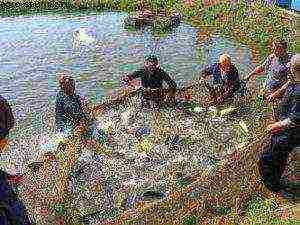 When breeding fish in natural reservoirs (ponds), you can offer customers paid fishing as an additional income.
When breeding fish in natural reservoirs (ponds), you can offer customers paid fishing as an additional income.
It should be remembered that the fish farming industry is not uncommon and competition among entrepreneurs can be fierce. In order to attract buyers, it is necessary to set prices several percent lower than those of other sellers. This will allow you to acquire regular customers and establish the necessary business connections.
Considering that the cost of fish starts from 100-120 rubles per kilogram, the investment can be recouped in one year, and sometimes in a shorter period. Business profitability can be up to 50%.
If positive results are achieved, it will be possible to expand production and bring it to a new stage, and, accordingly, to a new level of income.

